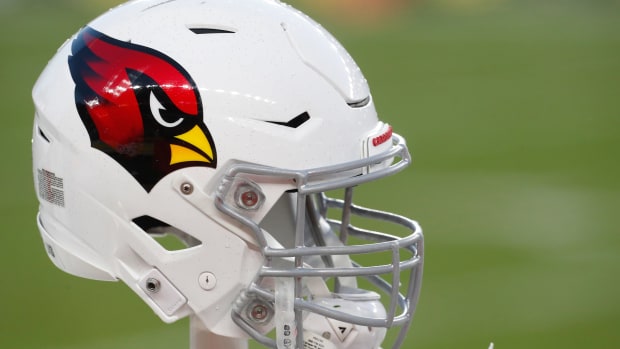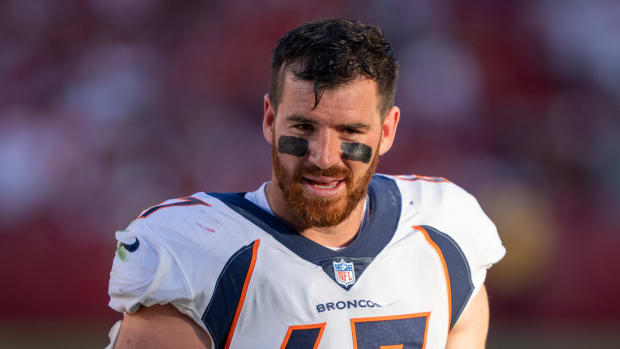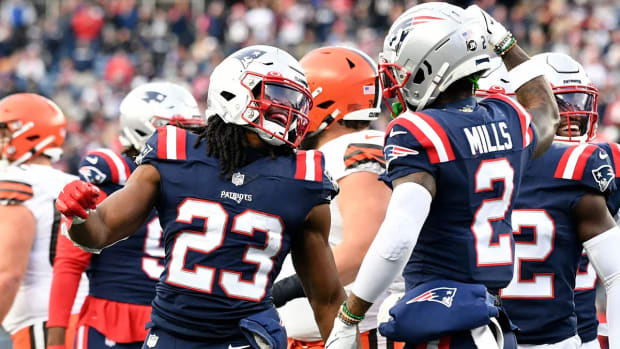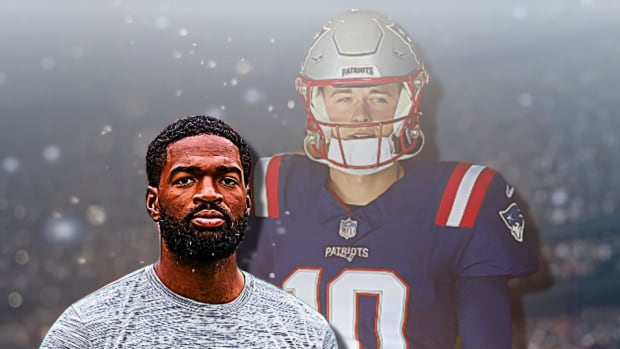Watching Doug Baldwin's game tape from 2014 with ... Doug Baldwin
In this series, SI.com's Doug Farrar reviews five plays with an NFL player to gain a better insight into how that player does his job. We've already spoken with Broncos guard Evan Mathis and Ravens running back Justin Forsett, and now, it's time to go under the hood with Seattle Seahawks receiver Doug Baldwin to learn how he's risen from anonymity to true value for his team.
Since coming out of Stanford and signing with Seattle as an undrafted free agent in 2011, Doug Baldwin has had a large, obvious chip on his shoulder. That chip has something to do with his undrafted status and his tough climb to the top of the Seahawks' receiver corps, but it goes deeper—Baldwin has always believed that determination, almost to the point of anger, is a key ingredient to his NFL success. That's why his teammates named him "Angry Doug" long ago, and that's why he's been the one to lash out when the media categorizes Seattle's receivers as pedestrian or mediocre.
Tackling the burning questions heading into 2015 NFL season
The 5'10", 189-pound Baldwin is always seeming to look for a fight, and if he has to blow things up to add to that chip, it's not a problem. During his time in Seattle, Baldwin has been perhaps the most definitive personification of an attitude Pete Carroll's Seahawks have traded on since Carroll became the head coach in 2010—you didn't want us, you ignored us, you discounted us and now, we're going to kick your ass for that.
Baldwin has never gained 1,000 yards in a season, and he's never made the Pro Bowl, but he's quietly set the standard for a group of targets who have slipped under the radar in recent years. Yes, the Seahawks' offense goes through Russell Wilson and Marshawn Lynch, but Seattle's passing game ranked 10th last year in Football Outsiders' opponent-adjusted ratings, and Baldwin ranked 14th among all qualifying receivers in quarterback rating when thrown to (ahead of Julio Jones, Demaryius Thomas and Calvin Johnson), so something's going right. Baldwin isn't the typical prototype of the alpha receiver, but given his humble beginnings, he's done pretty well for himself—and you'd be hard-pressed to find too many players more respected in his locker room.
• Subscribe to SI now and get your favorite framed NFL cover
“First off, when I think of Doug, I think of the great competitor that he is, and when he first got here, he was battling to prove that he belonged and fit in, and he did that,” Carroll told me this week. “He had a great first year with us. What kind of set the thing in motion is that he’s a guy to reckon with. He’s got such a great attitude, great habits and skill that he’s made a home for himself. With that, because he’s such a great competitor, he’s very aware and he does see what’s going on. He’s a good guy to help other guys, and visit with them and all of that. He feels kind of the natural responsibility in his room with his guys, the young guys, to help them and try to give them the best chance to be as good as they can be. He’s a marvelous team member for all of those reasons, and he comes through as well.”
Cornerback Richard Sherman, who was part of Stanford's receiver corps with Baldwin before he switched to defense in 2009, echoed Carroll's sentiments regarding Baldwin's value to the team.
NFL Crystal Ball: Predicting playoffs and awards winners for 2015
“He’s obviously matured,” said Sherman. “We have a relatively young receiver group and I think he’s the leader of the group, and he does a great job of doing his job and setting a great example. Obviously, it's not the most glamorous position, glamorized in the media or anything like that, but they do a great job blocking, doing what they’re asked to do, catching the ball on crucial downs in crucial spots, and making sure our [offense] goes. And I think over the years, he’s gotten a little less angry about it, and just more down to business. Take responsibility, be good at your craft, and appreciate every day. That’s what they’ve done, so I think he’s matured in that way.”
As far as what makes Baldwin tough to cover, whether in the slot or outside, Sherman spoke to the characteristics that have made Baldwin a valuable cog in Seattle's offense—against the odds.
“He’s a little guy. I’m just kidding. He’s really quick at the line of scrimmage. Obviously, he has his tricks at the top of the routes. He’s deceptively fast, I think all of this goes into it. And he’s just cagey; he’s a cagey vet now. He has his little tricks and trades for how to get open, and I don’t want to delve into those now, but he has them.”
To get to the bottom of those tricks and trades, I asked Baldwin to review five of his most interesting plays from the 2014 season. It's a remarkable insight into the style of a player who has always used his head—and may have more opportunities to do so as the Seahawks look to expand their passing game in the future.
• BEDARD: Picking the outcome of each and every NFL game this season
Play 1: Divisional game vs. Panthers, 1:01 1Q
SI: On this 16-yard touchdown pass, you get a free release off the snap when safety Colin Jones, ostensibly covering you in the slot, moves in on a blitz instead. This gave you a one-on-one matchup with safety Tre Boston, who you beat in the end zone by leading Boston slightly inside and them stuttering him outside. Two questions here: First, had Jones stayed on you, what are some of the option routes you might run in that play call (i.e., if the defender presses you at the snap, you do "X", and if the defender backs off, you might do "Y")? Second, with Carolina's secondary full of young players, did you have a feeling that you'd be able to use subtle spacing fakes more effectively, as on this play?
Bold predictions: Chargers dethrone Broncos, Eagles to NFC title game
Baldwin: The defense is playing what we call Cover-0. It's a typical coverage in the red zone because most teams think they can get to the quarterback faster than the receivers can get into their routes. However, offenses know this and practice against it. This is a simple Cover-0 blitz which Russ[ell Wilson] and I notice right away. We give each other the look and we make it happen. It's as simple as that. I don't remember what the concept prior to the adjustment was. If the defender was pressed, my move would be dictated off of the route I'm supposed to run and the defender's press leverage.
Play 2: Week 15 vs. 49ers, 0:29 2Q
SI: One of the challenges of working with a mobile quarterback like Russell Wilson is that you constantly have to keep your eye on the guy throwing the ball, and adapt your route to how he's moving. We've talked about this before, and this 35-yard completion with safety Antoine Bethea covering you is a prime example. What is your base route here, what are the options based on how you're handed off in coverage, and what happens when Wilson extends the play?
Start 'Em, Sit 'Em: How to set your fantasy lineups for Week 1
Baldwin: The challenge is more that you have an athletic quarterback who trusts his athleticism more than he trusts staying in the pocket. It happens a lot, so we as receivers have to be experts—not only on our route-running ability, but also on scramble rules. This play is an example of just that. At the snap, I have what we call a 'thru' route. I'm basically clearing the middle of the field out so the outside receiver can get a one-on-one match-up. The defense just had a better play call than us on this play. When Russ begins to scramble, we as receivers already know where everyone else is. We adjust our routes accordingly to mirror the quarterback's movements into an open area. Russ found me this particular instance.
Play 3: Week 14 vs. Eagles, 11:41 3Q
SI: Here's a 44-yard pass-interference penalty on Eagles cornerback Bradley Fletcher in which you're outside, running a straight vertical route, and essentially have to play defense after he smothers you. A few questions here: When you're up against a cornerback who is struggling like Fletcher was last season, does that change your approach at all? Do you anticipate moves that you might not against a guy like Darrelle Revis or Vontae Davis? And, how often are receivers tasked to practice what are basically defensive back drills to prevent interceptions from happening?
Baldwin: Honestly, I don't care what the perception of the player is to the outside world. NFL players get paid millions for a reason. I respect everyone I go against and study them just the same. On this play, I'm running a simple go route, more so to clear out coverage for the underneath routes. Again, the defense had a better call on this play. Fletcher is in off coverage which makes the go-route ball a difficult shot. The ball was also underthrown. I didn't really have any other option than to try and force pass interference, and it worked on this play. We don't really practice defensive drills; as a receiver, you just know what you have to do.
Play 4: NFC championship vs. Packers, 6:51 3Q
SI: So, this is where you guys were up against it the most, and this is the play that gave you just enough oxygen for the comeback. Time winding down in the third quarter, you're down 16–0, and after a sack and a series of penalties, you've got third-and-20 from the Green Bay 49-yard line. This is a weird play, because you've got Clay Matthews in the slot, and you're left completely alone as you run that intermediate drag route across the field for what became a 29-yard catch. What were your specific route responsibilities on this play, and were you surprised to be that open? How much of this was your own improvisation and sense of connection with Russell, and how much was planned?
NFL Power Rankings Week 1: Who opens the season atop the league?
Baldwin: This is one of our most basic route concepts. The defense is playing a preventive type zone defense because it is third-and-20. So no, Clay is not 'covering' the slot. He is assigned to that particular zone regardless of who is over there. Again, this is a situation we practice against. At the snap, I knew I'd be open. For whatever reason, it took Russ a little longer to find me. (As you can see, I'm jumping up and down waving my arms.) When we finally connected, it was enough to garner a first down and keep the drive alive.
Play 5: NFC championship vs. Packers, 12:36 OT
SI:Here's the penultimate play in the drive that took you to the Super Bowl and capped off that amazing comeback. You're in the middle slot, running an interesting route with Casey Hayward covering you. You're using some leverage and timing here. What is the route you're running, and what's the overall play construction here?
Baldwin: Third down situation. One-on-one with what we call a 'patch' route for me in the slot. It's as simple as that. The timing is because I can't get into my route too early. I have to give Russ enough time to go through his drop-steps. With this look, I should be number one in the read progression, so I don't wait too long. The leverage was created by the defender—think he had the wrong leverage on this play. After my release at the line, it's just a simple pitch-and-catch.
MythBusters: Are spread offenses the cause of offensive line decline?
SI: With teams going to more and more three-wide sets, slot receiver isn't an ancillary position anymore. What are the primary challenges of that position?
Baldwin: The slot receiver's kind of the quarterback of the receivers. More so because the slot receiver has more responsibilities in terms of reading coverages and different adjustments based on what coverages you're seeing. It's a lot more complicated... you have to know a lot more. You have to stay within the confines and the framework of the offense—you have a lot of freedom because you have a little bit more space, but at the same time, your job is usually to get someone else open, or to get open on a crucial down where it's one-on-one. You have to be versatile, and you have to understand how your route goes into the concept, based on the different coverages you can see.
Quarterback of the receivers? No matter where he lines up, that's a pretty apt description of what Baldwin has become for his team.









































